Japanese Knotweed, also known as Reynoutria japonica (formerly Fallopia japonica, and Polyganum cupsidatum) is a popular plant in the foraging world, but, I didn't find out about it through a wild food book or online group-I read about it in one of my favorite cookbooks: Provence Harvest by Jacques Chibois, as the plant is also known and appreciated by some chefs.
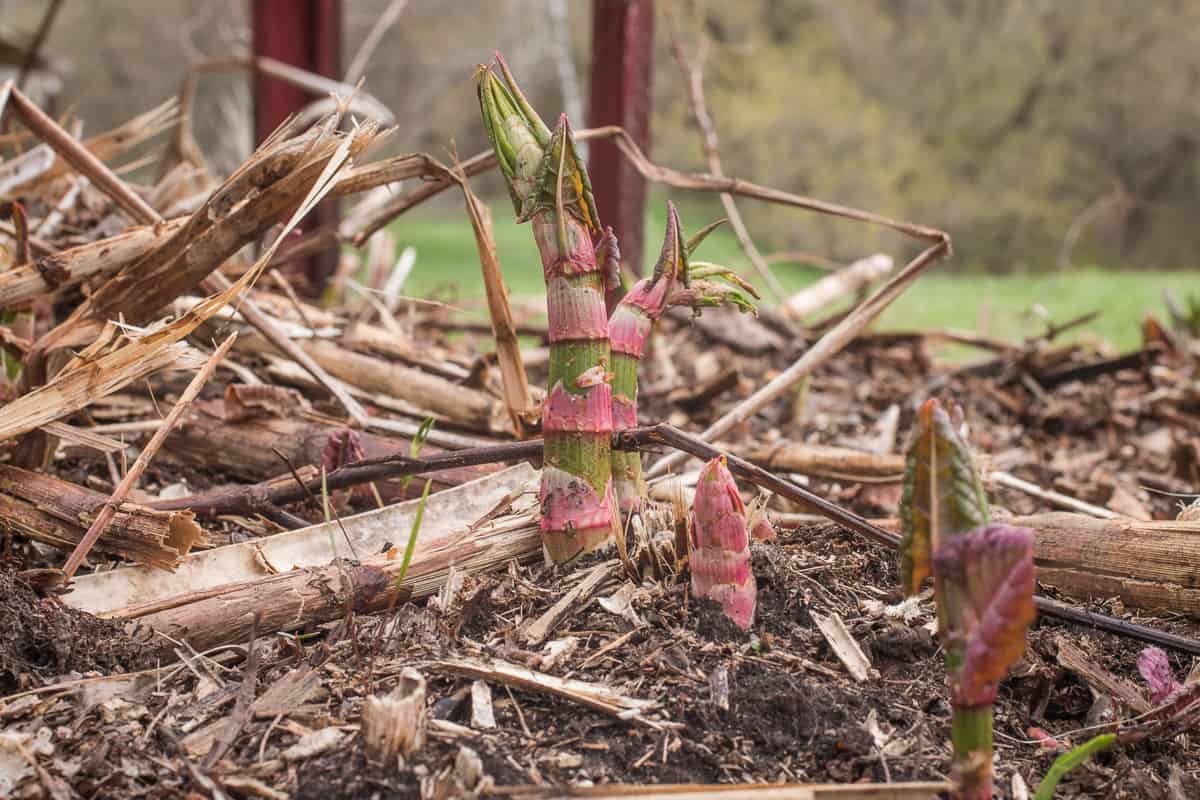
I'm going to share with you what I know about this strange plant that's related both to bamboo and buckwheat, covering some do's and don'ts you should know about harvesting, as well as an explanation of how I cook and prepare it using some of my favorite recipes.
Knotweed is Highly Invasive
Originally, the plant was brought to Europe as an ornamental, and, as is often the case, it spread, rapidly. It's a great plant for pollinators, but don't even think about planting it as an addition to your garden, no matter what someone tells you. Japanese knotweed is one of the most aggressive invasive plants in North America.
This should come as no surprise, as the plant resembles bamboo in its growth, which is also highly invasive and a danger to native species. See my note on caution near the end of the post for more on how to safely handle and dispose of the plant.
Japanese Knotweed Identification
The plant is easy to identify. Here's a few tips to help you.
- Often growing in large, pure stands or thickets like bamboo
- Stems are always hollow and segmented with a blotchy red coloration
- Leaves are triangular to heart-shaped with age
- Small white flowers appear at the end of the season
- Can reach heights of 10-15 feet
- Giant knotweed, a more rare variety, is much larger.
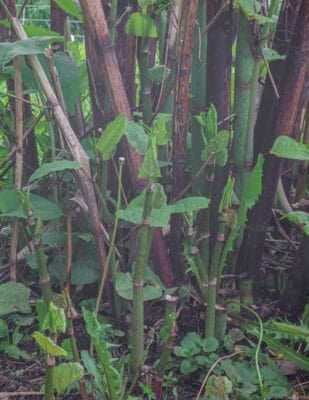
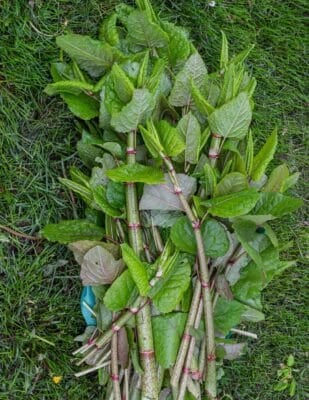
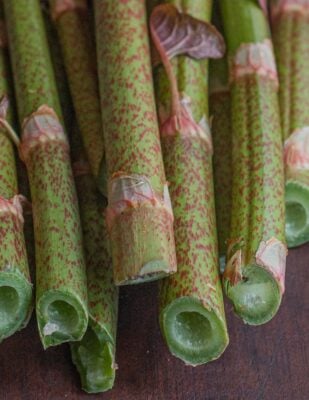
Where to Find Knotweed
If you don't know where any knotweed grows, look in disturbed areas, and places that have been forgotten or aren't tended much, like former gardens or abandoned lots. Just look for the tall, bamboo looking thicket below. I've spotted it in plenty of other places since, from parking lots, to gas stations and roadsides, near railroads, and plenty of other places-many of which can be sprayed by local authorities trying to remove the plant.
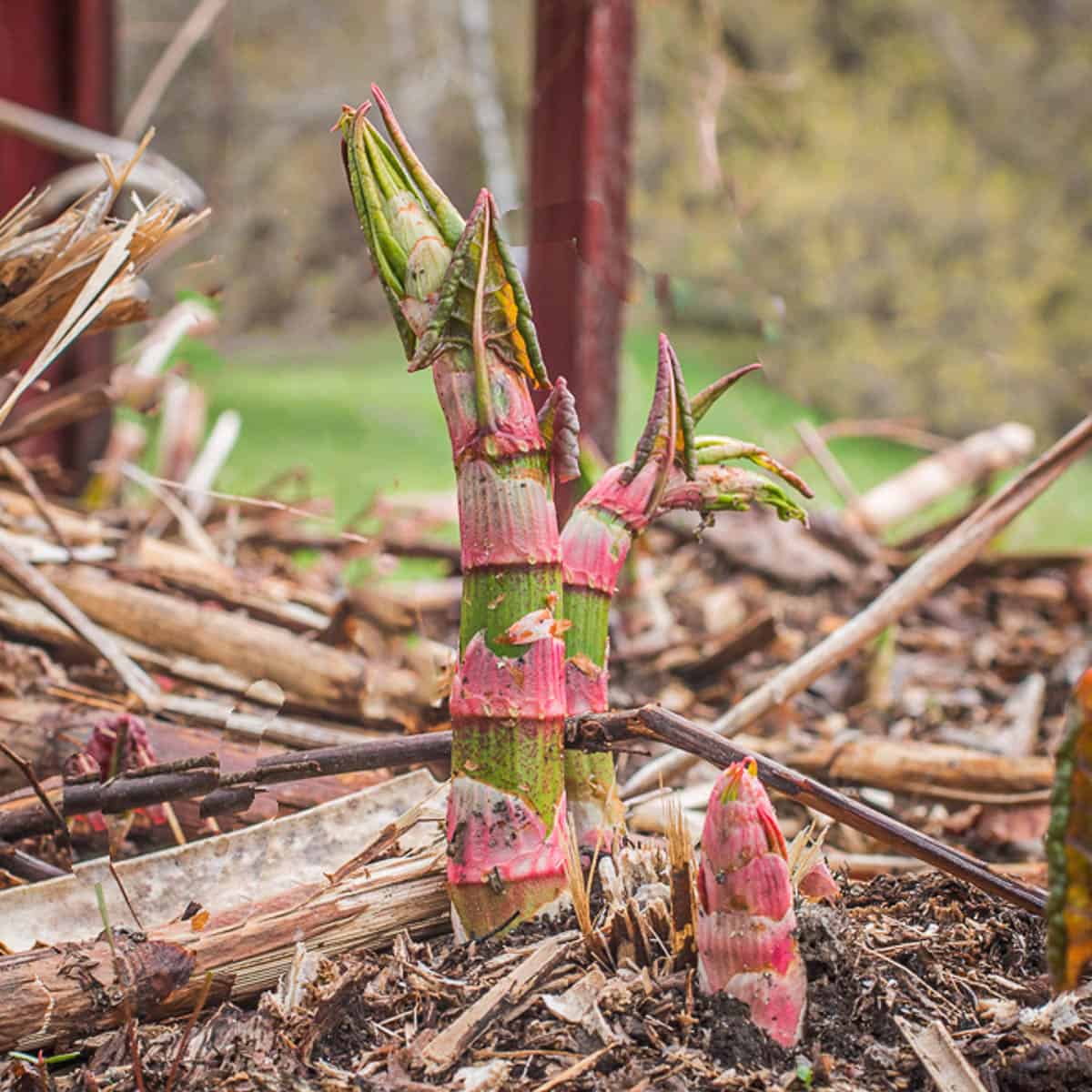
Proceed with Caution
Knotweed is edible, and many people like it, but there's two big points to keep in mind about it from my experience.
- Just because you found a big patch, doesn't mean you should eat it. Park service and state workers regularly spray knotweed colonies with herbicide in my area, especially along roads and railroads. If the plants look at all wilted or sickly, stay away.
- Don't compost your knotweed. Knotweed is related to bamboo, and can regrow like a literal plant zombie if you toss it in your compost. Bake, boil, microwave, incinerate, or otherwise denature any scraps you have from cooking to avoid an infestation in a place you live.
Controlling Japanese Knotweed
If you have knotweed on your property it can be a big problem. I've talked to a number of people who've tried to control the spread. Chemicals are often used, but the plant is really resilient, and no matter what you do, controlling it is going to be a continual process over the course of years.
It Spreads by Seeds and Rhizomes
Knotweed spreads both by seed, and under the ground through its root system. If you look closely at the image below, you can see some young shoots creeping into nearby areas away from the middle of the colony. I would wager the shoots come up in a radius of about 30 feet from the epicenter.
This means that to eradicate the plant, you may have to literally dig up the entire plot of ground. Things can get expensive quick. Below is a relatively small patch someone planted to attract pollinators about 20 years ago. The only way it's been kept in check is by regular mowing during the growing season.
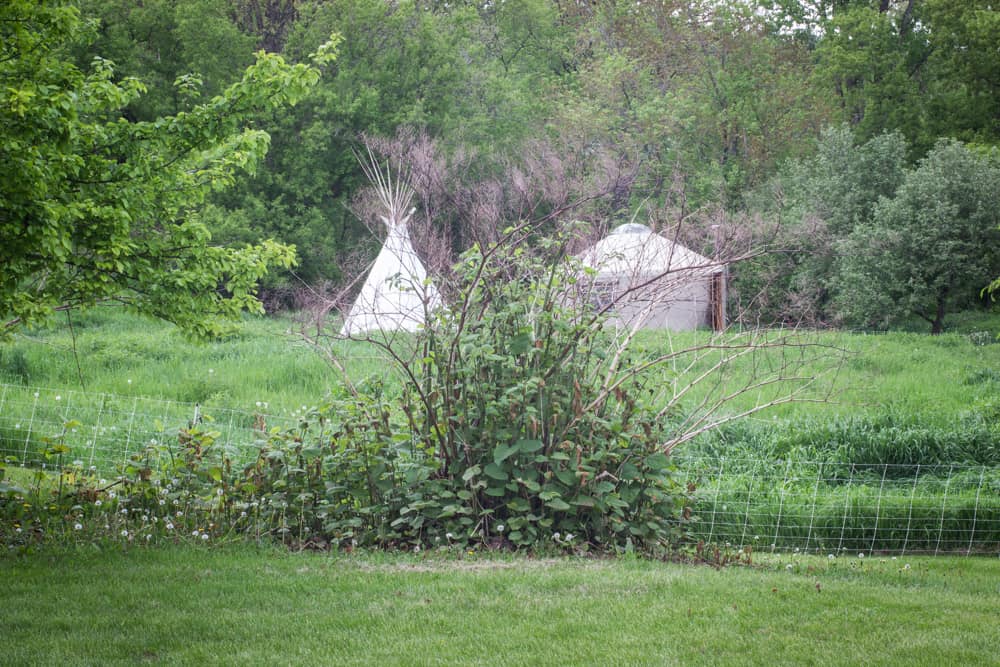
Harvesting Japanese Knotweed
Knotweed grows quickly, and you want to get it young, since it gets very stringy and fibrous as the shoots grow taller. If you come across some and they're already tall and leafy, make sure to look around and inside the network of shoots, there might be younger shoots that are just emerging and tender. Shoots about 1 ft tall or smaller are the best. The larger they are, the less flesh they'll have, and the tougher the skin will be. Leaves should be removed and discarded.
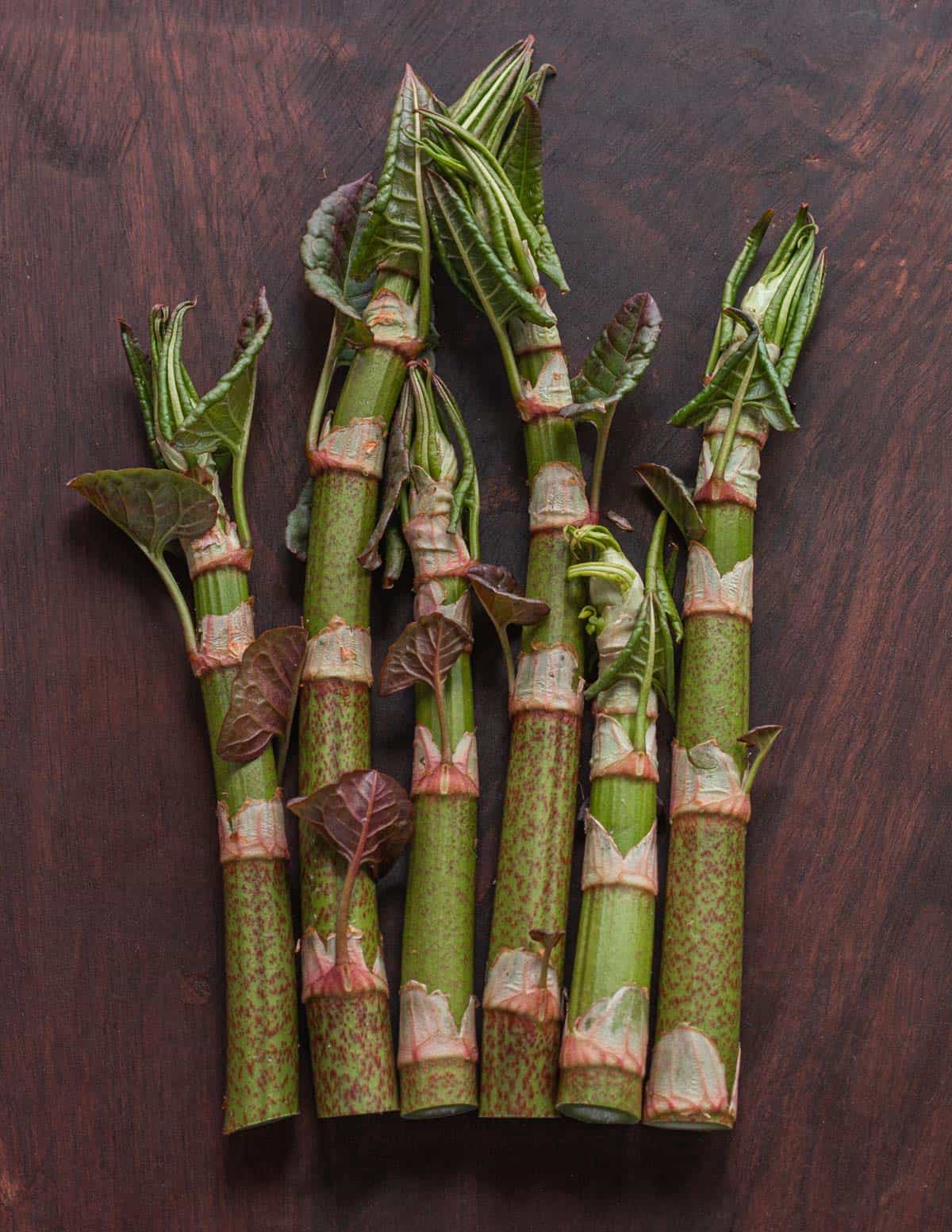
Disposal
After harvesting a bunch of shoots, you're going to have leftover scraps. Do not compost them. Here's what I do. As I'm working with the shoots in the kitchen, I put all of the knotweed peels and scraps into a ceramic bowl. After I'm all done, I microwave the bowl to kill the plant, making sure I don't have to eradicate it from the compost pile at a later date.
Resveratrol and Medicinal Uses of Knotweed
I try to stay away from discussing medicinal aspects of plants and mushrooms here, but I'd be lying if I said I didn't have hope for one particular component of this plant. Resveratrol is a plant compound (a polyphenol) found in a number of things (red wine for example).
The compound is thought to act like antioxidants, and has been used as a folk remedy for a number of ailments, including Lyme disease, which is pretty close to my heart as I'm a Lyme survivor myself. Knotweed is said to have one of the highest concentrations of the compound in any plant we know of. I suggest doing your own research on the topic if you want to know more.
Cooking Japanese Knotweed
Cooking will challenge a lot of people here, especially as it's an acquired taste. There are some things (pickles) that can be very good in the right place though. Here's my advice on cooking with it.
Taste
Japanese knotweed is related to rhubarb, so the first thing you'll notice is a sour tang from it. It tastes vaguely like rhubarb, but with a much more earthy quality that won't appeal to some. Where rhubarb pairs naturally with red, ripe fruits, knotweed is much more at home with fall fruits like apples, pears, and grapes. It's bit hard to describe.
Whenever possible, peel the stems
If the shoots I find aren't thick enough to peel, I'm probably not going to harvest them. The outer skin of the shoots has a stronger flavor than the inside, and will be stringy if the plants are older. For the best results here, you'll want a Kuhn Rikon peeler. Kuhns are a chef standard, and they're cheap-get a three pack and thank me later.

Knotweed Leaves
A lot of people ask me if I eat the leaves of the plant, and the answer is no. The leaves have an even stronger flavor than the stems, as well as being fibrous, so I always remove them before cooking. Don't feel bad about disposing of them.
Mucilage
Besides the flavor, this also turns a lot people off. As the shoots cook, or even if they're exposed to water, they turn slimy, quick. Cooking mellows the slime, but the texture of the hollow stems is, not pleasant, at least for me.
The stems disintegrate during cooking like rhubarb, but with a stringy texture that can be unpleasant, especially if the stems are older. Peeling the stems if at all possible to remove stringy fibers.
Pickling/Fermenting Knotweed
A reader tipped me off to fermenting knotweed, and it's since become my favorite thing to do with the best thick, green shoots. It's the best way to prevent the plant from getting slimy that I've found yet, and the best savory application.
If it's your first time working with the plant, skip down to the fermented knotweed pickles below and try those first.
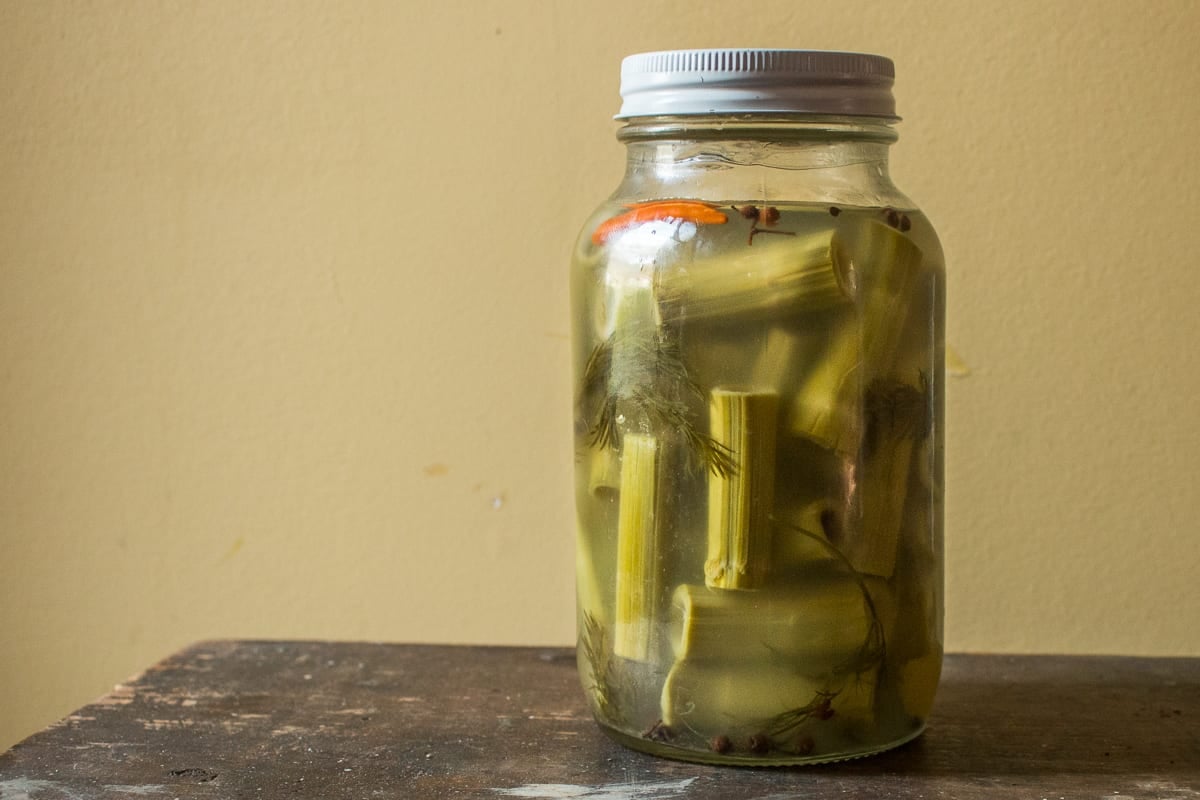
Knotweed Puree
When I harvested large amounts of shoots for my restaurants, I would have my pastry chef cook them down and make a smooth, lightly sweetened puree.

Like the paw-paw, which also has a funky texture after removing the seeds, making knotweed into a puree opens the door to possibilities, as well as bypassing the slimy, flaccid texture of the cooked shoot.
After the puree is made, I freeze it, to make a something with the knotweed I just pull some of the puree out of the freezer and fold it into things-banana bread for example.
Savory
I don't like knotweed as a vegetable unless it's very young and firm, and even then, It's probably going to be the fermented shoots mixed with other things, as in the relish on the trout below.
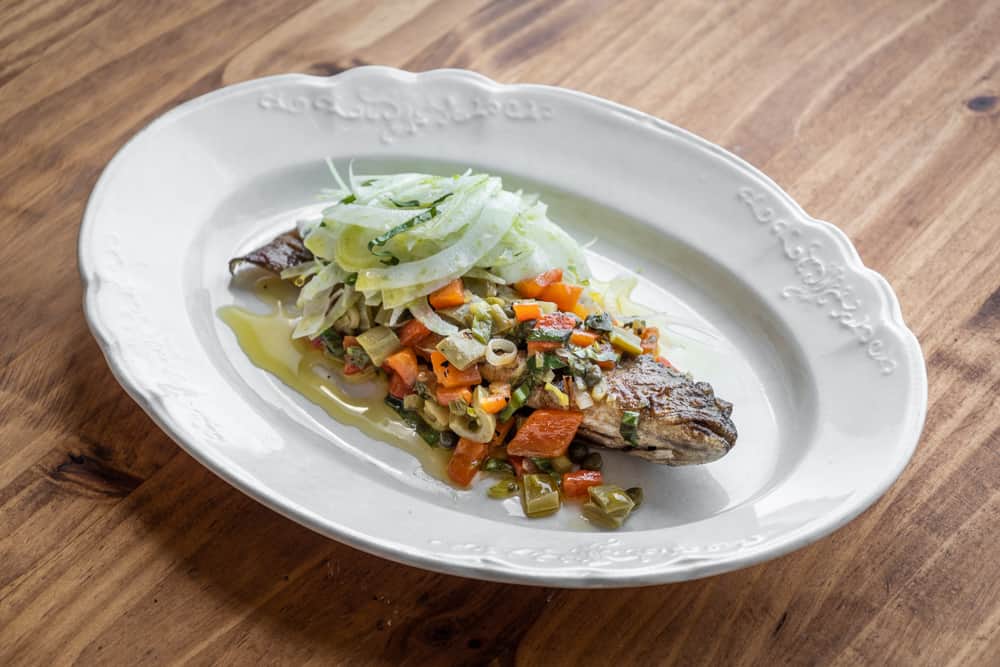
Use in Desserts
Sweet things are probably the easiest for most people to enjoy. As I mentioned, it pairs great with pears and apples. Other friends of knotweed are refreshing herbs like cilantro, lemon balm, spearmint or peppermint. It's also good with cream and dairy, as well as warm spices, which round out it's flavor.
Japanese Knotweed Recipes
This is can be a difficult plant to cook with, but I've come up with some handy ways to use it over the years. I've heard of a swamp-green knotweed tea boiled for hours and taken for medicinal effects, but personally I prefer it as a vegetable, or lightly sweetened.
Japanese Knotweed Pickles (Lacto-fermented)
My favorite savory application for the young shoots. You'll need fat, thick stalks you can peel.
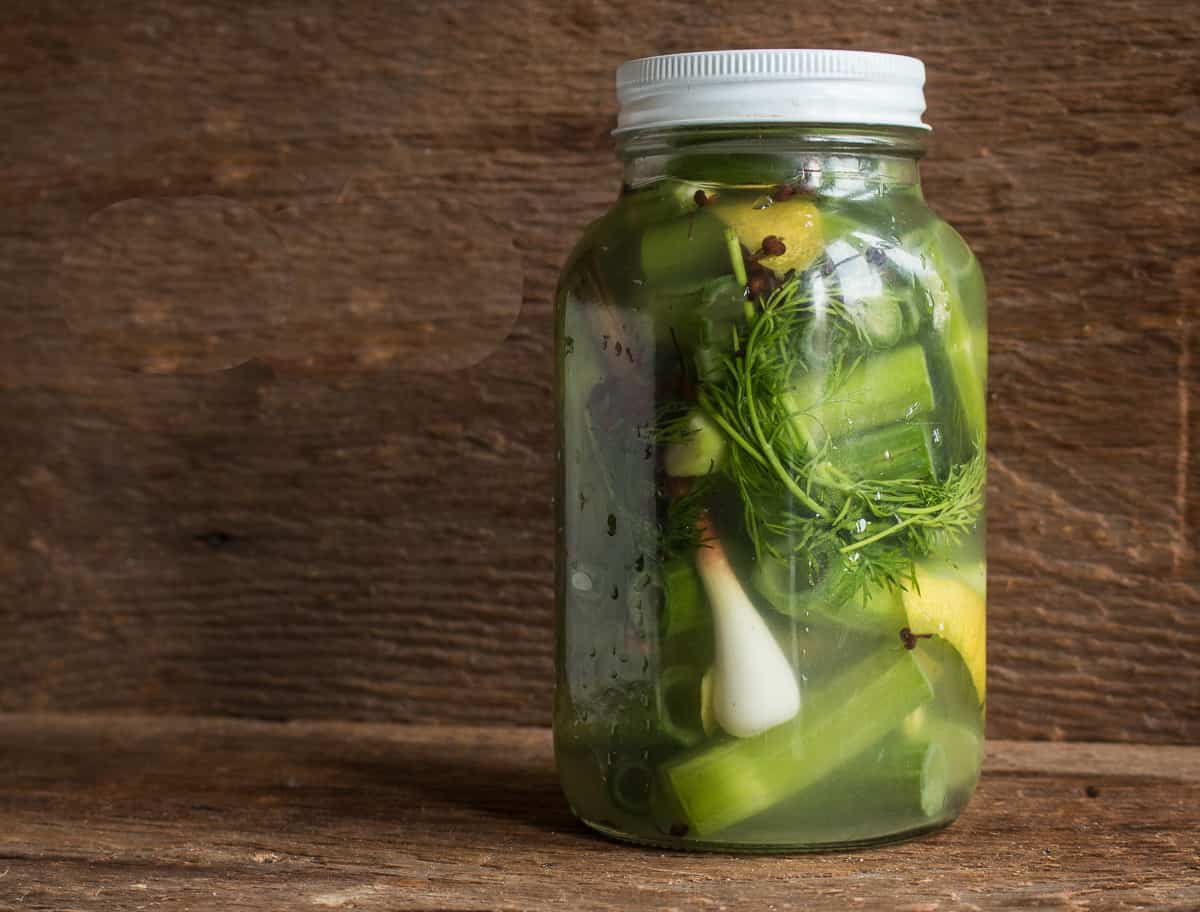
Japanese Knotweed Sorbet
Sorbet is my favorite thing to make with a puree of the stems. If you can peel them, it will be better for it.
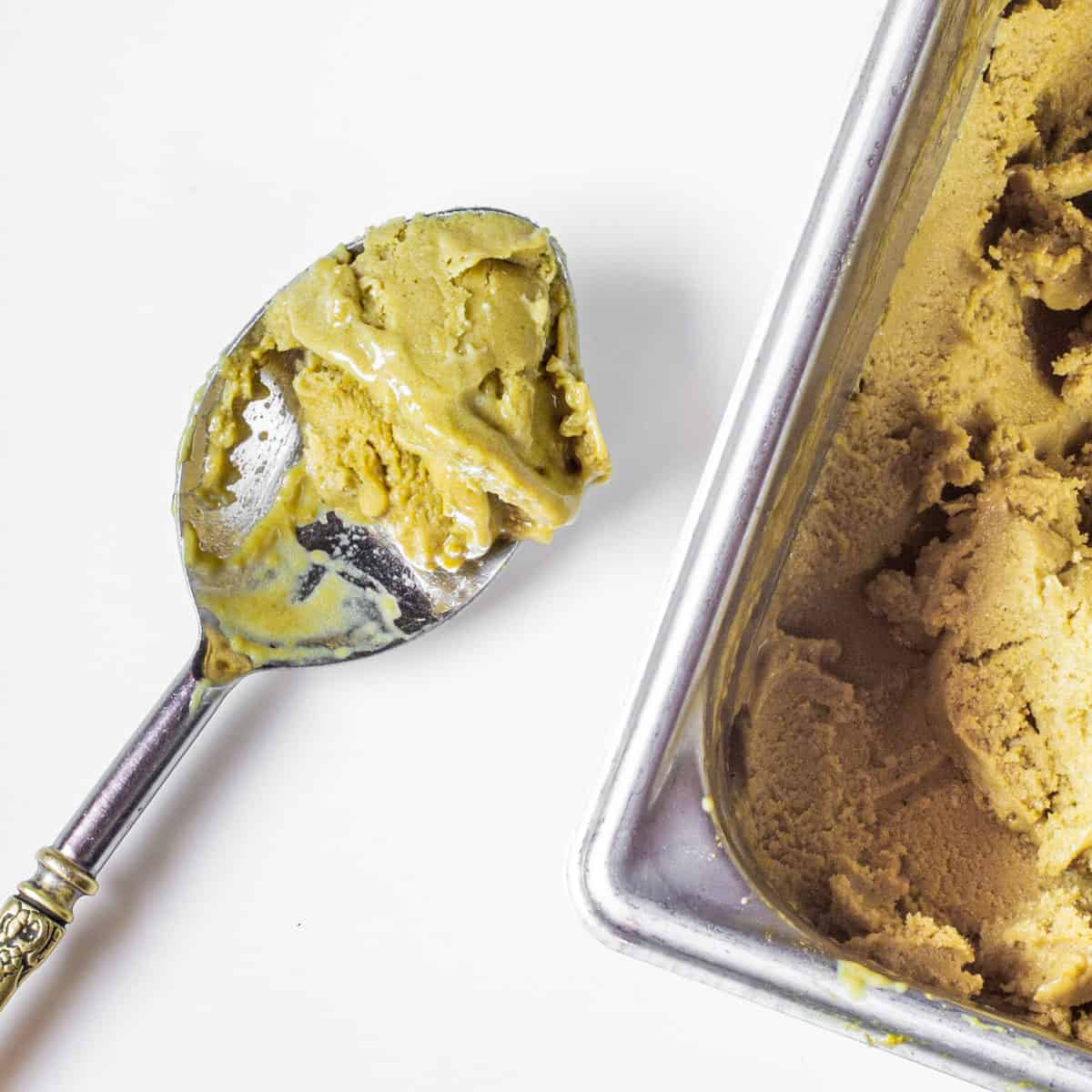
Knotweed Mousse
A simple, easy dessert made from knotweed puree and wild mint.
Mousse Cake
If you really love knotweed, you can try your hand at a jelly roll cake using the mousse above. It's frosted with maple buttercream, herbs and flowers.
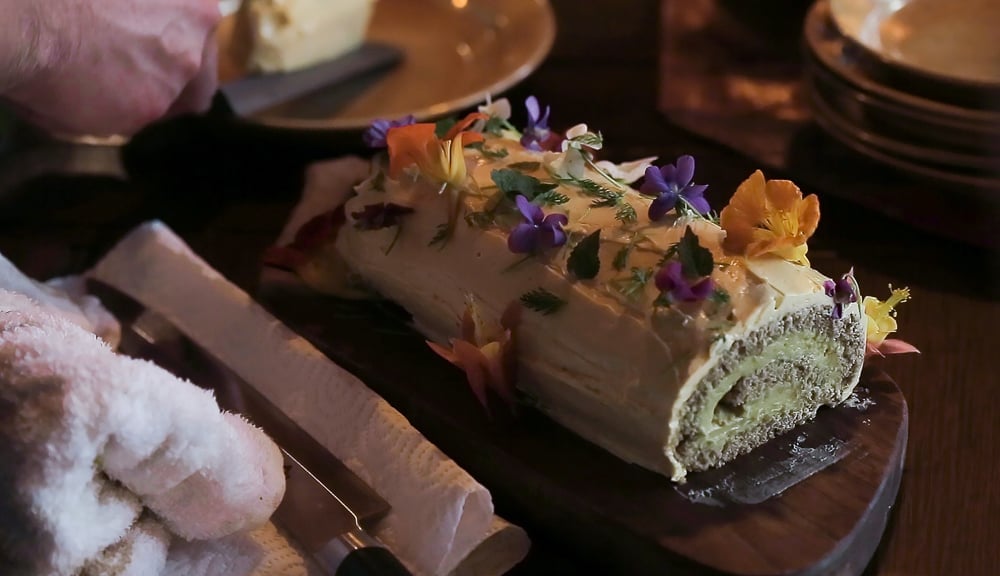
Knotweed Fruit Leather
Fruit leather is probably the easiest and most palatable thing you can make with the shoots. And if they're young, you don't need to peel them. I combine them with apples, cook, puree and dehydrate to make green fruit leather. It's surprisingly good.
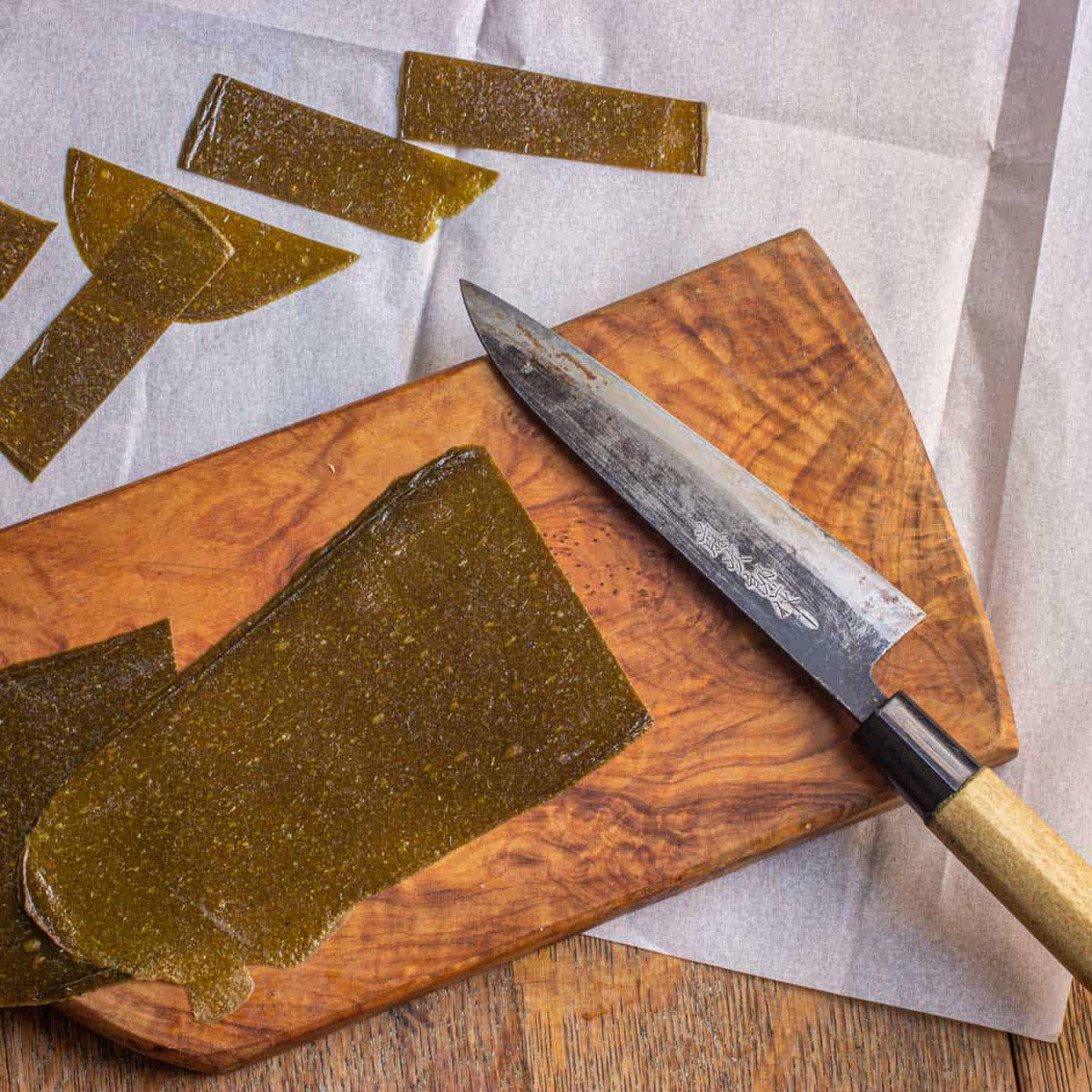

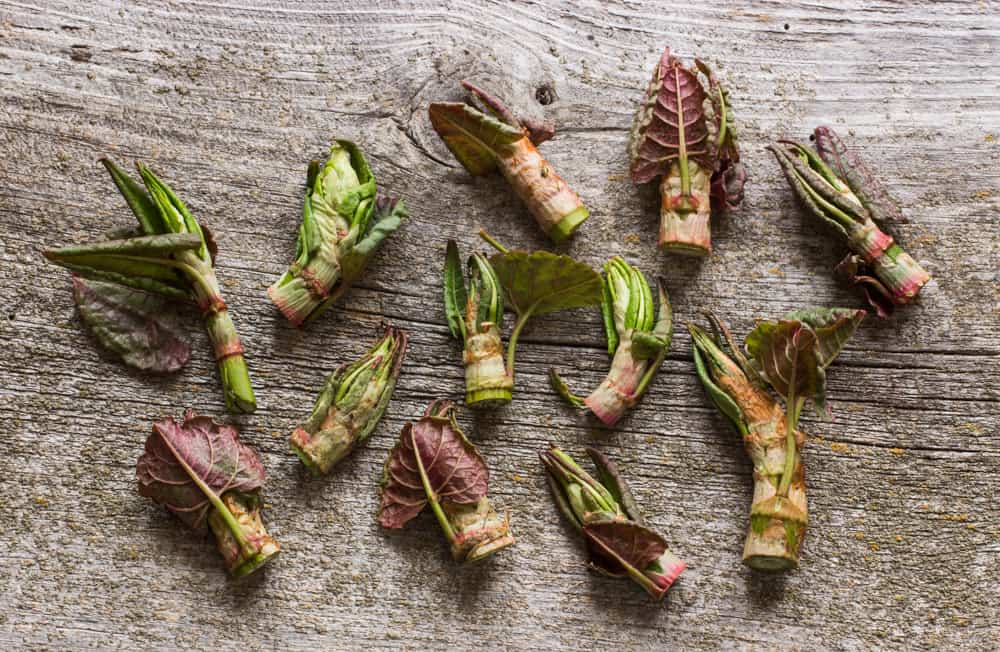

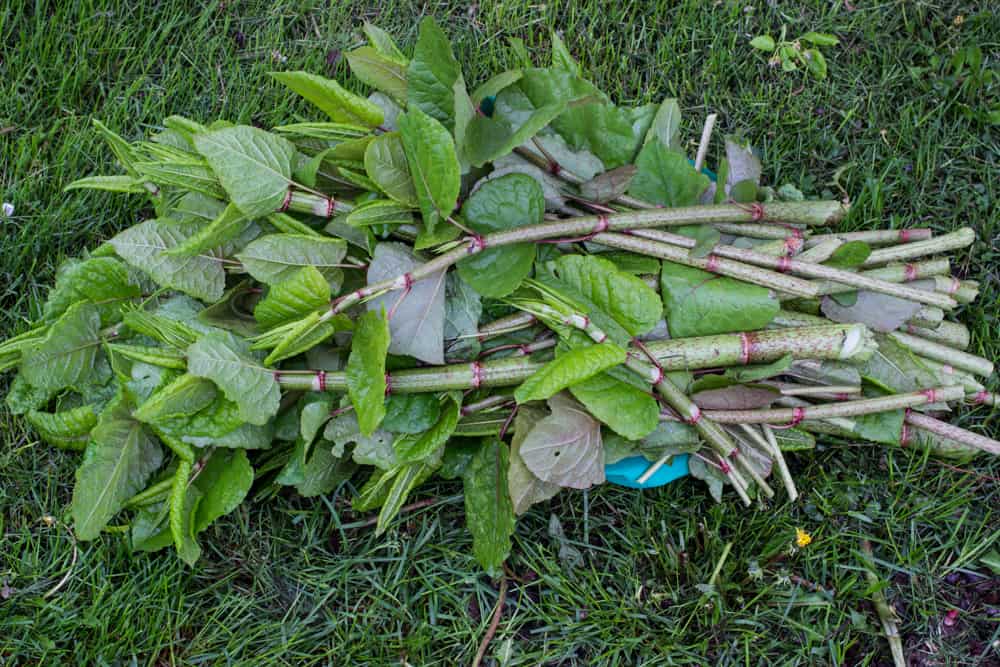
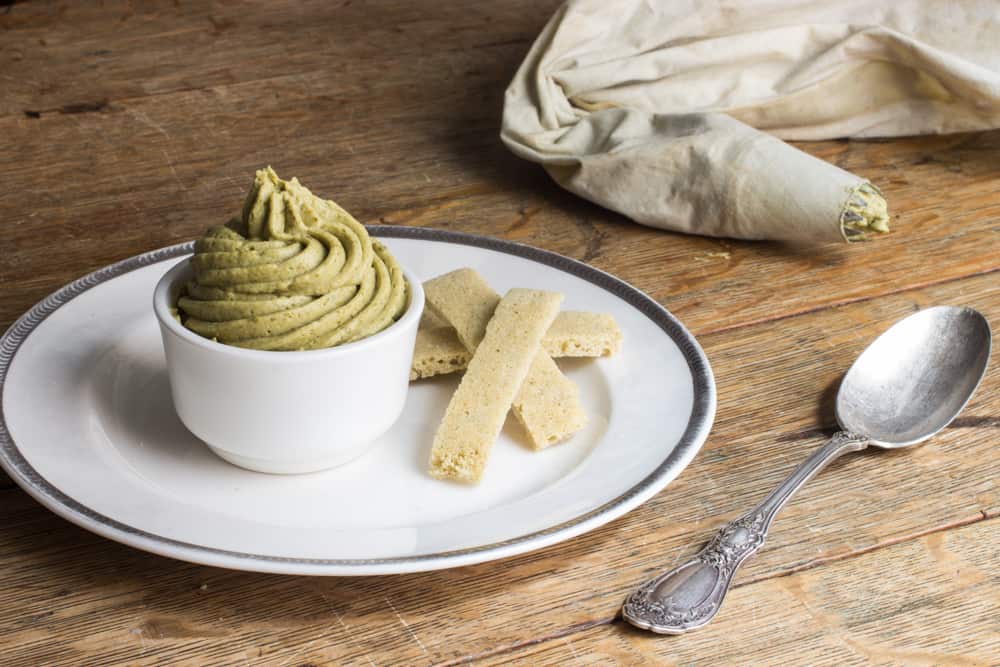
Raquel Thomas
I just started harvesting knotweed this year. There is a well established patch that has been there for years. I made a chutney out of it. It's not pretty but it is delicious. Can't wait to try your pickle recipe.
Alan Bergo
Have fun Raquel
sylvia bennett
could you use this plant like building material as you would bamboo
Alan Bergo
I wouldn’t think so it’s not nearly as sturdy.
Mike Townsend
I'm just learning around eating this plant and it's benefits, but I will tell you that you DO NOT want to plant this on your property! My home had three patches of it. The one near the garage was so thick that as I hacked it down I discovered an old swing set. I had to dig up as many of the very long rhizomes as I could, and if you leave even a tiny root tip, expect it to come right back the next year. I had to lay down blue stone next to the garage and for at least 5 years go after any shoot that popped up. I still have two other patches near the creek and woods that grow bigger every year. It takes a lot of effort to remove it, so to those who think this plant is a god-send, they probably don't have property where it takes over everything else that can grow. If you plant it, you best want to eat it for life and have it every week! And your kids and the grandkids will need to like it as well.
Would the roots have the resveratrol as well or just the shoots?
Alan Bergo
Hey Mike. Agreed. I’ll pick it when I see it but it will never live on my property. I can’t speak to the resveratrol, but roots are often stronger in compounds than above ground parts.
Will Dell
Japanese knotweed is related to the Buckwheat family, Bamboos. Are Grasses.
Sage
Thought tou'd be interested in seeing there is currently a clinical trial looking at the effects of Resveratrol on bone loss/ Osteoperosis
https://clinicaltrials.gov/study/NCT06250283?locStr=United%20States&country=United%20States&cond=Bone%20Loss&aggFilters=status:not%20rec&rank=11
Alan Bergo
Hey thanks for sharing that.
Saskia
Hi Alan! Mmm such a tasty treat this green explosion!
I was trying to find how knotweed is related to bamboo, I only think they're in the same clade, Angiosperms, but that's rather high up to call them related, right? But I would love to know if I'm missing something (I'm no botanist by far :)), cause they do look a bit similar! Thanks for your time.
Ciao, Saskia from Outsiders Foraging
Alan Bergo
A distant relation.
Susan
Japanese knotweed isn't really related to bamboo--bamboo is a grass and Japanese knotweed is a dicot. They just look similar because of their jointed stems.
Alan Bergo
Thanks Susan.
A E
Was wondering whether it'd be possible to cultivate if grown inside custom reinforced cement raised beds? I've seen bamboo contained this way, but you said this also spreads by seed...I suppose it would still decrease the spread, but more obnoxiously (spreading further from it's origin).
But I also read the comment stating mowing is a simple method of control as it kills the rhizomes relatively quickly - your article seems to example this, so wonder if that's overkill. Do you have any thoughts about this, Alan?
Anyway, thanks for this article, the mucilage reminds me of using okra, and okra pickles are delicious and not at all slimy. I don't mind the slime because of the respiratory and g.i. benefits, but I get the turn-off.
Alan Bergo
Hi AE I wouldn't try that. The plant is soooo invasive.
Cheryl Sargent
I live in oregon. We have tons of this plant in our back yard. We thought it was bamboo. It gets over 10 feet tall. The honey bees love it during the late summer months. I did not know it was edible or that it was an invasive plant. Just thought it was a form of bamboo. Its growing amongst cedar trees, blackberries and nettles.
Rebecca
Does anyone know one way or the other whether knotweed can survive the digestive tract? I’m assuming with a municipal system the water would be treated to a point that it wouldn’t survive (maybe?), but I wonder about other systems?
Alan Bergo
I would highly doubt that knotweed could survive all the enzyme and chemical warfare of the GI tract.
Alison
Thanks for all the ideas! I just harvested a ton of this stuff from my neighbor’s yard. He looked at me like I was a little crazy, but now I’m going to boil it all down and see what I can make with it.
Alan Bergo
Have fun.
Elizabeth
I have made wine with it- pretty nice after a year or two resting! It can be used like rhubarb in cooking, too! Fresh young stalks are nice in salads and soups. Iti s medicinal, high concentration of resveratrol, can perhaps control/prevent Lyme's disease. Read all about it:
https://foragerchef.com/japanese-knotweed/
Lucy Birkett
Hi- thank you for your generosity and information sharing. a pile of early knotweed shoots sit on my counter (it was a sponateous harvest) and i am looking foward to my project ahead. Before I do- i felt important to send this comment. This species of knotweed is NOT helpful for most pollinators (in US). Although in the short term, sure, the honeybees will use it as a nectar source. But long term (and actually quite rapidly), the spread of knotweed is devastating to native pollinator populations. It quickly and vastly replaces native plants (who are native pollinator host plants/habitat)- not just native herbs but shrubs and trees as well. In my region, Maine, we (should) have 220 native bee species and at least that many (or more, i don't have the number) of lepidoptera species (butterfly & moth), but their numbers are quickly declining due in large part to habitat loss (and yes, pesticides). Knotweed (and some other plants who behave invasively in their non-native regions) will actually knock out tremedously large swaths of native plants- and then there is literally nothing for the associating insects to eat, and they are gone, and then it's the assoicating birds (usualy song birds, migrating birds) and it goes on from there. I realized that there is a lot to know, when it comes to ecology and ecosystems. Links to articles re topics such as this can be helpful. I am speaking up out of care, that correct info gets out there. This one being so important for us human folks to understand. Thank you for listening! And again thank you for your EXCELLENT culinary and foraging advice and for the great inpsiration you provide!
Alan Bergo
That's helpful. Everyone I've talked to, including my mentors, who are much more knowledgeable than me, have told me they were beneficial for pollinators, but how much, and especially, at what cost, is definitely something to consider! A dense topic to unpack.
Eurhi
In Pennsylvania, USA, knot weed is everywhere blanketing stream edges and choking out natives plants.
I feel good about eating it!
I love it puréed with apple, absolutely delicious on my morning toast
Alan Bergo
Thanks for sharing Eurhi.
Joan
Glad to seee some thoughtful information about knotweed here.
Curt Esident
I grew up with knotweed (Japanese rhubarb) on our property. It's prolific, but a beautiful deep green & provides quick shade. It is much more visually appealing than many other wild plants. I watched my mom eradicate an entire acre of the stuff when she decided to turn the back yard (formerly untamed growth) into a lawn. How did she get rid of this "aggressive, prolific weed"? With regular mowing. That's all. it seems to bounce back quickly at first, but the root system (rhizome) will eventually run out of energy & will lose it's ability to send shoots above ground with repeated mowing. Today, the back yard is a beautiful lawn with a wall of short trees & thick growing knotweed bordering on 3 sides. This plant is NOT the villain that it's made out to be. As we know, it's edible. Some animals such as deer will forage it. It's loaded with resveratrol. Has anyone tried their hand at making WINE with it yet? In parts of the world where hunger is a real problem - plants like this are a God-send. Because the stalks are hollow, they cut with a machete easily. The plants responds to such cutting by rapidly sending up new shoots (which are the preferred edibles). As long as man decides to be "at war" with nature ... he will be at war with nature. I have found that with some DEEP THOUGHT, things that are perceived as liabilities can often be turned into assets. Look at history and you'll see that this is true.
Terry Cohoe
I love this take. We get caught up in eradicating everything, much to our own detriment.
Elizabeth
Yes! I made wine with it two years ago- becomes lovely after a year or so. And it is considered medicinal.
Recently I discovered there is actually a recipe in a Wild Wines book for Japanese knotweed wine (I had make up my own recipe) which I will try next Spring.
Sue
I’d would like to know the nutritional benefits to knotweed if anyone has that handy please
Gilbert
One way to find out from reliable sources, append pubmed to your search terms.
Rahela
Do you know if knotweed flowers are edible?
Alan Bergo
They should be fine. I've eaten them raw.
Stephen
Japanese Knotweed has become a big problem in Ireland. There are signs put up on roadsides warning people not to cut it down as even a tiny fragment of the plant can take root. I think it is even illegal to put into compost bins.
Rhubarb is known to go well with mackerel so I was thinking knotweed might be a good accompaniment to mackerel too.
Alan Bergo
I could definitely see that, mackerel is such a nice, fatty fish. Try my lacto knotweed pickles I posted recently--really good with fish.
Carla Beaudet
Alan, if the goal is to just preserve the knotweed in the freezer, is there any reason not to omit the sugar and just freeze the unsweetened puree? I have 10 lbs of the stuff in my kitchen right now, and I've got to do something with it tomorrow!
Jacqui
Of course you can freeze it as is (in my opinion). I also just cut it up and freeze it raw, as I do with rhubarb but that takes up more freezer space than the purée because of all the air. And the big advantage is that if you freeze it unsweetened you can later incorporate it into sweet OR savoury recipes. I generally prefer savoury over sweet, so take this comment with a grain of salt, but I make a pitch for the fish cakes again - this year I made them with thai red curry paste and coconut and incorporated about 1/6 of the total of chopped knotweed stems. I think it would also be excellent in chicken or lamb/mutton brik (but I have not made this yet) or in tagine.
Carla Beaudet
Hi Jacqui, that's exactly it - I want to leave the option for savory on the table. (Pun intended) I was just wondering whether the sugar plays a role in making the purée more freezer worthy, but it sounds like no worries there. Currently, I am using about a cup of purée to thicken an asparagus bisque. The flavors of the asparagus and the knotweed seem to play pretty well. I am excited to try lactofermenting some of this - in my imagination that's a slimy mess, but you say it worked?!? I'll give it a whirl.
Alan Bergo
Lacto fermenting them is great.
Sebastian
Firstly, as a resource for using and cooking this plant I’ve enjoyed this articles contents.
Secondly, it should be known that Japanese Knotweed is not a close relative of bamboo. Bamboo is a grass belonging with other monocots while Japanese knotweed is of the eudicots with a much separation from bamboo in its taxonomic tree
Alan Bergo
Thanks Sebastian.
Jacqui
Hi Carla,
I just ate a bowl of crispy knotweed stem dill pickles that were sitting on the counter after lunch (without dripping brine on my keyboard). I admit that the greyish green colour leaves a bit to be desired, but the texture is EXCELLENT. And if you just keep them under a 2,5% brine (DON'T ADD VINEGAR!) there is no slime to be seen. I peeled the stalks right to the top because they are easy to peel and the fibres can be rather annoying and then split them so that I could pack them together into the jar. I put some ramps leaves, some dill and a piece of hot pepper in the bottom of the jar and packed in the pieces of stem, most of them standing up, until I could't get any more in. Then I filled the jar with my cooled 2,5% (non-iodised) salt brine (25 g per litre - this is easier in metric) and made sure that nothing floated up or poked out of the brine by placing a smaller jar in the mouth of my pickling jar and adding a bit of water to weigh it down. You can use a plastic bag full of brine too but I avoid plastic all I can.
Very simple, very good.
I very much appreciate your comment about the pharmaceutical industry.
Carla Beaudet
Thanks for the details, Jacqui! I have a modest amount of lactofermentation experience, but it's nice to know exactly what others are doing. I'll stick to the 2.5%, and hey! I've got a few ramps in the fridge right now, so why not? Best regards.
Alan Bergo
Totally fine to omit the sugar if you want a savory option.
Aase
I used a Norwegian recipe for rhubarb soup, replacing rhubarb with knotweed, and it was delicious. 250g Knotweed, 1+ liter water, 150g sugar, thickened it with 2tbs potato starch. Its good warm or cold, but when it was cold I could top it with a spoon of whipped cream. Kids loved it too.
Jesandoval
We recently bought a house in Illinois that has a large hedge that looks like knotweed. Before I attempt to use it as food I want to make sure there is no ornamental look a-likes that are dangerous to eat. I really want to make the fermented pickles! Thank you for such an educational and informative site.
Alan Bergo
Feel free to send me some images through my email if the pictures in this post aren't helpful enough. alanbergo3 AT gmail.com